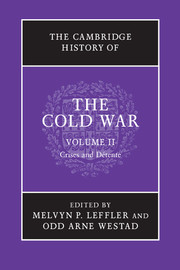Book contents
- Frontmatter
- 1 Grand strategies in the Cold War
- 2 Identity and the Cold War
- 3 Economic aspects of the Cold War, 1962–1975
- 4 The Cuban missile crisis
- 5 Nuclear competition in an era of stalemate, 1963–1975
- 6 US foreign policy from Kennedy to Johnson
- 7 Soviet foreign policy, 1962–1975
- 8 France, “Gaullism,” and the Cold War
- 9 European integration and the Cold War
- 10 Détente in Europe, 1962–1975
- 11 Eastern Europe: Stalinism to Solidarity
- 12 The Cold War and the transformation of the Mediterranean, 1960–1975
- 13 The Cold War in the Third World, 1963–1975
- 14 The Indochina wars and the Cold War, 1945–1975
- 15 The Cold War in the Middle East: Suez crisis to Camp David Accords
- 16 Cuba and the Cold War, 1959–1980
- 17 The Sino-Soviet split
- 18 Détente in the Nixon–Ford years, 1969–1976
- 19 Nuclear proliferation and non-proliferation during the Cold War
- 20 Intelligence in the Cold War
- 21 Reading, viewing, and tuning in to the Cold War
- 22 Counter-cultures: the rebellions against the Cold War order, 1965–1975
- 23 The structure of great power politics, 1963–1975
- 24 The Cold War and the social and economic history of the twentieth century
- Bibliographical essay
- Index
- References
16 - Cuba and the Cold War, 1959–1980
Published online by Cambridge University Press: 28 September 2010
- Frontmatter
- 1 Grand strategies in the Cold War
- 2 Identity and the Cold War
- 3 Economic aspects of the Cold War, 1962–1975
- 4 The Cuban missile crisis
- 5 Nuclear competition in an era of stalemate, 1963–1975
- 6 US foreign policy from Kennedy to Johnson
- 7 Soviet foreign policy, 1962–1975
- 8 France, “Gaullism,” and the Cold War
- 9 European integration and the Cold War
- 10 Détente in Europe, 1962–1975
- 11 Eastern Europe: Stalinism to Solidarity
- 12 The Cold War and the transformation of the Mediterranean, 1960–1975
- 13 The Cold War in the Third World, 1963–1975
- 14 The Indochina wars and the Cold War, 1945–1975
- 15 The Cold War in the Middle East: Suez crisis to Camp David Accords
- 16 Cuba and the Cold War, 1959–1980
- 17 The Sino-Soviet split
- 18 Détente in the Nixon–Ford years, 1969–1976
- 19 Nuclear proliferation and non-proliferation during the Cold War
- 20 Intelligence in the Cold War
- 21 Reading, viewing, and tuning in to the Cold War
- 22 Counter-cultures: the rebellions against the Cold War order, 1965–1975
- 23 The structure of great power politics, 1963–1975
- 24 The Cold War and the social and economic history of the twentieth century
- Bibliographical essay
- Index
- References
Summary
Cuba’s role in the world since 1959 is without precedent. No other Third World country has projected its military power beyond its immediate neighborhood. Brazil sent a small troop to the Dominican Republic in 1965 as the United States’ junior partner; Argentina’s generals briefly helped Anastasio Somoza’s defeated cohorts in 1980–81 as they sought to regain a foothold in Nicaragua; Vietnam’s soldiers never ventured beyond Indochina; China’s military activities outside Asia have been limited to the supply of weapons and the dispatch of a few hundred instructors to Africa. During the Cold War, extra-continental military interventions were the preserve of the two superpowers, a few West European countries, and Cuba. Moreover, West European military interventions in the thirty years between the rise of Fidel Castro and the end of the Cold War pale in size and daring compared to those of Cuba. The dispatch of 36,000 Cuban soldiers to Angola between November 1975 and April 1976 stunned the world; in early 1978, 12,000 Cuban soldiers went to Ethiopia; by 1988, there were 55,000 Cuban soldiers in Angola. Even the Soviet Union sent far fewer troops beyond its immediate neighborhood than did Cuba. In this regard, Cuba is second only to the United States.
- Type
- Chapter
- Information
- The Cambridge History of the Cold War , pp. 327 - 348Publisher: Cambridge University PressPrint publication year: 2010
References
- 1
- Cited by

